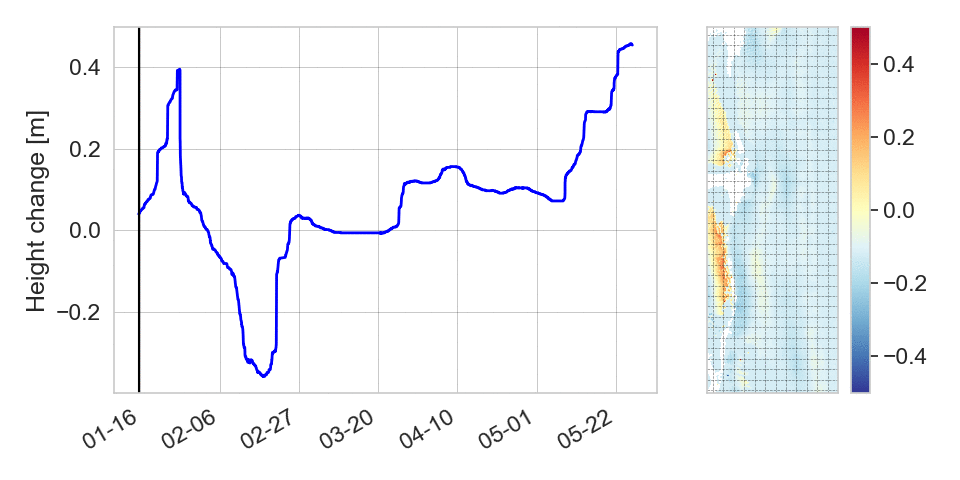E-TRAINEE - E-learning course on Time Series Analysis in Remote Sensing for Understanding Human-Environment Interactions
The E-TRAINEE course is hosted on GitHub and can be accessed here: https://3dgeo-heidelberg.github.io/etrainee/
News
Research news can be found in our GIScience News Blog. Follow our updates on X/Twitter: #ETRAINEE #3DGeo
Find all infos around the project on the official E-TRAINEE website.
New paper:
- Potůčková, M., Albrechtová, J., Anders, K., Červená, L., Dvořák, J., Gryguc, K., Höfle, B., Hunt, L., Lhotáková, Z., Marcinkowska-Ochtyra, A., Mayr, A., Neuwirthová, E., Ochtyra, A., Rutzinger, M., Šedová, A., Šrollerů, A., and Kupková, L. (2023): E-TRAINEE: Open E-learning course on time series analysis in remote sensing. The International Archives of the Photogrammetry, Remote Sensing and Spatial Information Sciences. Vol. XLVIII-1/W2-2023, pp. 989–996.
Motivation
Processing of time series of remote sensing data is a challenging goal of today’s and future research. Global Earth observation programmes provide extensive image archives dated back to several decades. Aerial images and LiDAR point clouds are acquired on the national level in two to three years cycles. Specific localities are monitored on regular (hourly, weekly, monthly, yearly) basis for research purposes such as monitoring resistance of plants to droughts, invasive species encroachment, melting of mountainous snow and glaciers, desertification, decrease of biodiversity, deforestation or urbanization.

Surface change extracted from the spatiotemporal information in large 4D geospatial data (Anders et al. 2020)
Thus, processing methods of the time series of remote sensing data of different time and spatial scales, the combination of heterogeneous and multi-modal data sources and accuracy assessment of the obtained results are becoming a key part of remote sensing and geo(infor)matics curricula.
Objective
The project’s objective is to develop a comprehensive research-oriented open e-learning course on time series analysis in remote sensing for environmental monitoring. The course offers a multidisciplinary approach connecting themes from computer science, geography, and environmental studies.
It combines well established and latest technologies of remote sensing (satellite and UAV sensing, multispectral and hyperspectral sensing, 3D point clouds) and methods of artificial intelligence (machine and deep learning) in order to use these technological developments to understand environmental changes and interaction of human activities and environment. It shows how the same environmental phenomenon can be analysed from the perspective of different data sources, scales and time frequencies.
Moreover, it increases students’ digital literacy in time series analysis in remote sensing, which comprises the improvement in methodological and practical data handling skills. The students also gain the skills for critical reflection and communication of complex data processing tasks, enabling them for transformative and interdisciplinary research missions.
Background
This collaboration project is funded in the framework of the Erasmus+ programme of the European Union with Markéta Potůčková (Department of Applied Geoinformatics and Cartography, Charles University Prague) as PI of the project and Heidelberg University, University of Innsbruck and University of Warsaw as project partners. It follows the alliance built up through the 4EU+ collaboration project 3D Landcover Monitoring
The 3DGeo research group supports this project with contents on 3D/4D geospatial point clouds and methods for their analysis, including machine learning, time series analysis, and laser scanning simulation. Contents will further comprise programming for point cloud analysis in Python and research-oriented case studies.
Publications
- Anders, K. (2023): Time Series Analysis of 3D/4D Point Clouds within the Open-Source Online Course E-TRAINEE">Time Series Analysis of 3D/4D Point Clouds within the Open-Source Online Course E-TRAINEE (Conference Talk). 5th Virtual Geoscience Conference, Dresden, 20-22 September 2023.
- Potůčková, M., Albrechtová, J., Anders, K., Červená, L., Dvořák, J., Gryguc, K., Höfle, B., Hunt, L., Lhotáková, Z., Marcinkowska-Ochtyra, A., Mayr, A., Neuwirthová, E., Ochtyra, A., Rutzinger, M., Šedová, A., Šrollerů, A., and Kupková, L. (2023): E-TRAINEE: Open E-learning course on time series analysis in remote sensing. The International Archives of the Photogrammetry, Remote Sensing and Spatial Information Sciences. Vol. XLVIII-1/W2-2023, pp. 989–996.
- Potůčková, M., Albrechtová, J., Anders, K., Červená, L., Dvořák, J., Gryguc, K., Höfle, B., Hunt, L, Lhotáková, Z., Marcinkowska-Ochtyra, A., Mayr, A., Neuwirthová, E., Ochtyra, A., Rutzinger, M., Šedová, A., Šrollerů, A., Kupková, L. (2023): E-TRAINEE: Open E-Learning course on time series analysis in remote sensing. ISPRS Geospatial Week, Cairo, 2-7 September 2023.
- Albrechtová J., Anders K., Červená L., Dvořák, J. Kupková, L., Lhotáková, Z., Neuwirthová, E., Šrollerů, A., Anders, K., Bernhard Höfle, B., Mayr, A., Rutzinger, M., Marcinkowska-Ochtyra, A., Ochtyra, A., Gryguc, A. (2023): E-learning on time series analysis in remote sensing: the way towards collaborative course development. 42nd EARSeL Symposium, Bucharest, 3-6 July 2023.
- Marcinkowska-Ochtyra A., Albrechtová J., Anders K., Červená L., Gryguc K., Höfle B., Kupková L., Lhotáková Z., Mayr A., Ochtyra A., Potůčková M., Rutzinger M. (2022): Using time series of remote sensing data to understand human-environment interactions - new E-TRAINEE e-learning course (original title in polish: Wykorzystanie serii czasowych danych teledetekcyjnych w celu zrozumienia interakcji człowiek-środowisko - nowy kurs e-learningowy E-TRAINEE), 28-30.11.22 (online).
- Marcinkowska-Ochtyra A., Albrechtová J., Anders K., Červená L., Gryguc K., Höfle B., Kupková L., Lhotáková Z., Mayr A., Ochtyra A., Potůčková M., Rutzinger M. (2022): Understanding human-environment interaction - new e-learning E-TRAINEE course based on remote sensing time series data (original title in polish: Zrozumieć interakcję człowiek-środowisko – nowy kurs e-learningowy E-TRAINEE oparty na seriach czasowych danych teledetekcyjnych), GIS Day 2022 - GIS w stolicy, 23.11.22, Warsaw, Poland.
- Rutzinger M, Albrechtová J, Anders K, Červená L, Gryguc K, Höfle B, Kupková L, Lhotáková Z, Marcinkowska-Ochtyra A, Mayr A and Potůčková M (2021): E-learning on Time Series Analysis in Remote Sensing and Geoinformatics for Understanding Human-Environment Interactions – a concept. In: 15. Jahrestagung AK Hochschullehre Geographie - Digital Lehren und Lernen.



